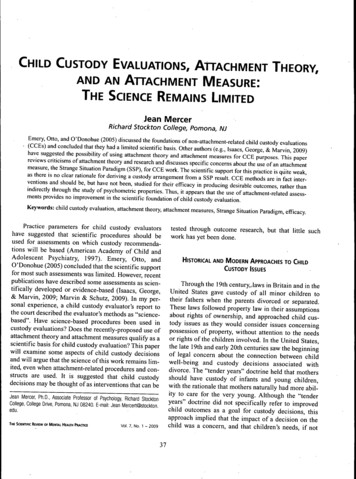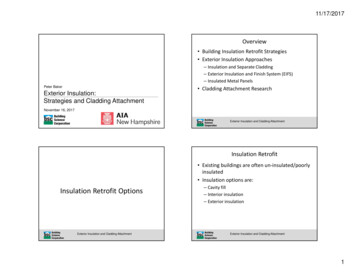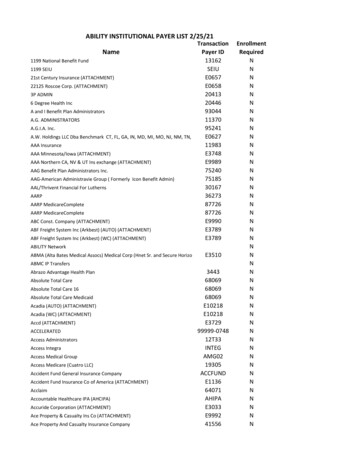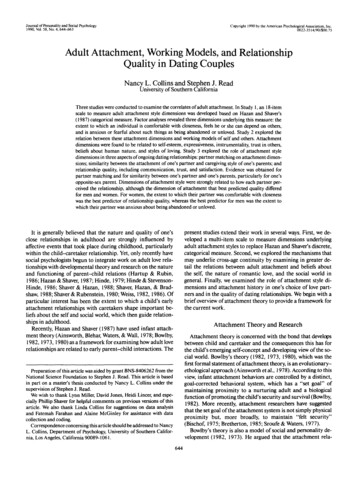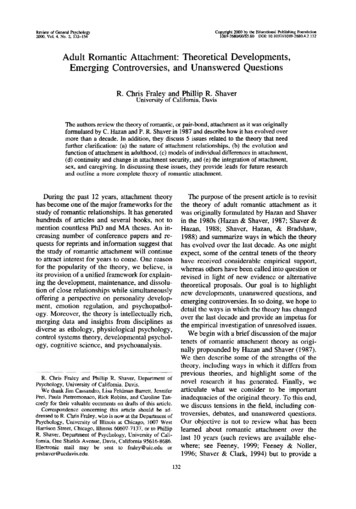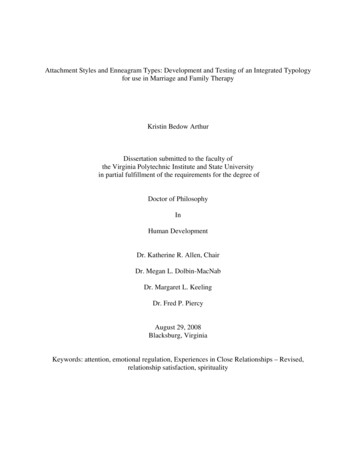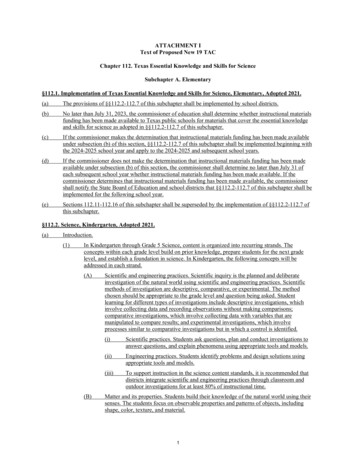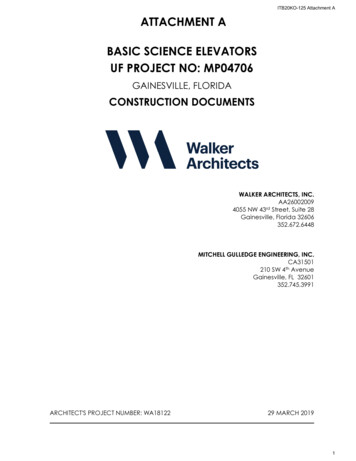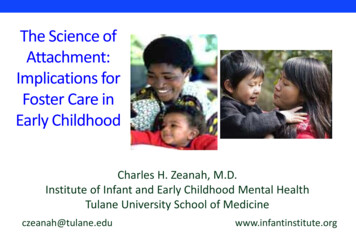
Transcription
The Science ofAttachment:Implications forFoster Care inEarly ChildhoodCharles H. Zeanah, M.D.Institute of Infant and Early Childhood Mental HealthTulane University School of Medicineczeanah@tulane.eduwww.infantinstitute.org
The Science of Parent Child Attachmentin Early Childhood—What Do We Know?
John Bowlby the quality of the parentalcare which a child receives inhis earliest years is of vitalimportance for his futuremental health. essential for mental healthis that an infant and youngchild should experience awarm, intimate andcontinuous relationship withhis mother (or mothersubstitute ) in which bothfind satisfaction andenjoyment.--1952
What is attachment?Attachment as a bondAttachment behaviorAttachment as amotivational systemAttachment relationship
Attachment behaviors Behaviors of the infant/young child designed topromote physical proximity to caregiver/attachmentfigure. Crawling to Clinging on Walking to Smiling Crying Reaching for
Motivational systems in young ess
Attachment exploration balanceactivatedattachmentexplorationdeactivated
Relationship domainsParent Emotional Availability Warmth/Empathy/Nurturance Provision of Comfort ProtectionChild Emotion Regulation Security/InterpersonalTrust Comfort Seeking Vigilance/Self-Protection
Relationship domains (cont.)ParentChild Play Play Teaching Learning/Mastery/Curiosity Structure/InstrumentalSelf-Regulation/Adaptationto Routines Self-ControlCare/ Routines Limit-Setting/ Discipline
Attachment relationship domainsParent Emotional Availability Warmth/Empathy/Nurturance Provision of Comfort ProtectionChild Emotion Regulation Security/InterpersonalTrust Comfort Seeking Vigilance/Self-Protection
Development of Attachment First 2 months 2-7 months 7-12 months 12-20 months 20-36 months
Parents’ affiliative feelings for baby For most women, attachment grows as pregnancyprogresses For a small minority strong attachment in the firsttrimester By one month after birth, should have experiencedfeelings of love for baby Mothers’ attachment greater than fathers’throughout pregnancy
Attachment: Birth to 2 months Physical characteristics ofbabyishness attractscaregivers Discrimination limited bycognitive immaturity Preferences limited toolfactory and auditoryrealm
Differential brain activation to adult and infant faces
Attachment: 2 to 7 months Differentiates amonginteractive partners May seem morecomfortable with primarycaregiver Social with everyone andpreferences not stronglyexpressed
Attachment: 7 to 12 months Stranger warinessapparent Separation protestbegins Hierarchy ofpreferred caregivers
Attachment: 12 to 20 months Use of attachment figure as asecure base from which toventure out and explore Use of attachment figure as asafe haven to which to returnif distressed or frightened Proximity to caregiverpromotes an internal feeling ofsecurity in infant
Circle of SecurityParent Attending to the Child’s NeedsI needyou toI needyou toSupport MyExplorationI needyou to Protect meComfort meDelight in meOrganize my feelingsWelcome MyComing To You I needyou toWatch over meHelp meEnjoy with meDelight in me
Attachment: 20 to 36 months Goal-corrected partnership Increased appreciation of conflicting goals and of theneed to negotiate Balance between autonomous functioning andhealthy dependence Cooperation is hallmark
Attachment Attachment is a relationship construct –not a trait ofthe child may be different with different caregivers Consistency and emotional availability fromattachment figures are critical to foster healthyattachment
Levels of discrimination betweeninfants and caregiversIt’s not just attached or not nce
Attachment: Review Infants are strongly biologically predisposed to formattachments to caregiving adults Adults are strongly biologically predisposed to respond toinfants Attachment in young children develops gradually over thefirst several years of life, based upon relationship experienceswith caregivers Under usual rearing conditions, infants develop “focused” or“preferred” attachments in the second half of the first year oflife (7-9 months of age). Separation protest Stranger wariness
Attachment: Review Once infants reach a cognitive age of 7-9 months,they have capacity to form attachments Attachments form within days to weeks afterinfants are old enough to construct them Young children need literal, physical contact tosustain attachment relationships. Attachments may be qualitatively different withdifferent caregivers
Attachment: Review Through experiences with attachment figures, baby developsexpectations about the dependability of attachment figuresto provide comfort, support, nurturance and protection intimes of need. These expectations guide babies’ behavior in intimaterelationships. Strongly predictive of child’s subsequent social adaptation.
Attachment Attachment is a relationship construct –not a trait ofthe child may be different with different caregivers Consistency and emotional availability fromattachment figures are critical to foster healthyattachment
Implications for Foster Care
Continuum ofcaregiving approachesOverwhelmingly consistent evidence favoring foster care overinstitutional careFamily preservation has dismal results other than Homebuildersmodel which is more encouragingStreetChildrenLargeinstitutionsSmaller groupsettingsFoster careHigh qualityFoster careOrphaned, abandoned and maltreated children requiring societal intervention
Basic premise of foster care Foster care is an intervention designed toprotect children who have been maltreated. Interventions can be helpful or harmful. Foster care is demonstrably better than itsalternatives—family preservation or institutionalcare. Emphasis should be on improving the quality offoster care.
Models of foster care Latent models of contemporary foster care Extended respite model Safety is essence Food, clothing and shelter Placeholding Child centered model Love child as one’s own Full psychological commitment
A Model of Child Centered, Healthy Foster t/CommitmentValuing Child asAn IndividualPlacing Needs ofChild FirstParent Behaviors Safe Securely Attached Socially Competent Emotionally WellRegulatedChild Outcomes
Attachments to foster parents Can children who have experienced deprivation,maltreatment and/or disruptions in care develophealthy attachments in new placements? Yes -- at about the same rate as seen for biologically intactdyads -- but much more likely when the new caregivers aresecurely attached When placed with less secure caregivers, these children areat greatly increased risk for developing problematic(disorganized) attachments.Dozier et al., 2001
Secure vs. insecure: 42 months836549513517Smyke et al., 2010
Disorganized attachmentamong foster and intact dyads7133189Dozier, 2006
Why Foster Care for Young ChildrenMust Be Different
Reasons why foster care for young childrenmust be different than for older children Older children and adults, but not young children,are capable of sustaining attachment relationshipsacross time and space. In order to protect young children adequately, fosterparent must become primary caregiver and primaryattachment figure for a young child. The young child cannot wait. The young child needs literal physical contact to sustainattachments. Emotional availability and dependability are crucial.
Reasons why foster care for young childrenmust be different than for older children(cont.) Safety, stability and emotional availability ofthe caregiving adult are paramount. Foster parents must psychologicallyinvest/commit in child in order to becomeattachment figure.
Challenges of Foster Care
Popular ContemporaryViews of Foster Care
Miami Herald“When the 6-year-old girl was discoveredmissing from a foster care home in Miami, FL,in April 2002, it turned out the case workerassigned to check on her at least once a monthhad not seen her in at least 15 months .The state later admitted it had lost track of 393children in its care; 290 were found by year’s end,but others were still missing .The scandal points to a broken system ofsupervision and accountability .”
Providence Journal BulletinCarcieri was unaware of foster care problemsTuesday, July 3, 2007By Steve PeoplesJournal State House BureauGovernor Carcieri said he was completely unaware of widespread physicaland mental abuse that allegedly plagues Rhode Island’s child-welfaresystem as outlined in a sweeping civil-rights lawsuit filed in federal courtlast week.Speaking publicly about the suit for the first time yesterday, the governorsaid his office is investigating specific allegations regarding 10 childrencited in the court filing, but that there were no immediate plans to moveany children or discipline staff. And Carcieri largely denied suggestionsthat the system designed to care for foster children in Rhode Island isbroken .
L.A. Times 3/13/04Foster Care Agency's Supervision ScrutinizedAn infant was beaten to death in his fosterhome this week, and an investigation ofstate documents showed that the agencythat monitored the baby's home had a historyof violations in homes it certified .
20/20 ABC News.comA Foster Care NightmareA Story of Betrayal andSurvivalBy Brian RossMay 24 — They are five brothersand their sister who stucktogether in the face of what isdescribed as almost perversecruelty, without an adult in sight.to save them ."These children were tortured. These children were neglected. These childrenwere abused," says Howard Talenfeld, a family-rights attorney.
ScholarsRichard Gelles, Ph.D., Joanne and Raymond Welsh Chair of ChildWelfare and Family Violence at the University of Pennsylvania:“Our child welfare system is in trouble. One obvious problem isthe failure to protect children from harm that is reported bylocal media almost weekly .When tragedies occur, the mantra-like claim is that the child ‘fellthrough the cracks in the system.’ These are not small cracks.They are national fault lines: long, deep, and always on theverge of swallowing up more victims.”
The state of young childrenin foster care Nearly 80% have prenatal exposure to substances More than 40% are premature or low birthweight More than half suffer from serious physical healthproblems More than half have developmental delays For a significant number, immunizations not up to date,referrals for delays do not occur, and emotional andbehavioral problems not addressedDicker, Gordon & Knitzer, 2001
Inherent Contradiction in Foster Parenting Psychological Ownership Love the child as their own Advocate for child Become the child’s “Go - to” person Uncertainty Child can be removed at any time Progress of biological parents
Other Challenges in Foster Parenting Isolation/lack of support Repeated attachments and separation from childrenin their care Insufficient or inadequate training Caring for children who have experienced attachmentdisruption(s) Behavioral/emotional difficulties “He’s suffered enough” Syndrome
Applying Child-Centered Foster Care
Applying child-centered foster care Disruptions and transitions Visits Kin Care
Disruptions and Transitions
Barriers to Attachment in Children:Disruptions in Foster Care Disruptions are harmful after attachments areestablished (7-9 months) After 12 months are even more harmful thandisruptions before 12 months. From child’s perspective, impossible tounderstand.
Transitions Planful and thoughtful The Robertson story Adding attachment figures
Visits
Principles of child-centered visitation Child’s well-being is a concern on par with parents’right to visit. Child must have an attachment figure present duringvisit if more than 6 months old. Better to have an attachment figure present even if lessthan 6 months old. Children less than three or four years old must beaccompanied to and from visit by an attachment figure. Biological parents are prepped before the visit anddebriefed after the visit.
Levels of discrimination betweeninfants and caregiversIt’s not just attached or not nce
Principles of parent child visits (cont.) Young children can sustain relationships (but notattachments) to parents throughout foster placement. Attachment building efforts begin after parents have accepted responsibility for children’s maltreatment begun recovery from mental health/substance abuse problems. demonstrated they are making progress towards reunification. Relationships with foster parents should continue afterreunification whenever possible.
Visits Adults are capable of sustaining attachmentrelationships across time and space. Adults should bear the burden of difficulties – notyoung children. who visits whom? travel and familiarity of setting biological relatedness does not trump stability
Decision Tree: Child’s Visitswith Biological ParentsChild harmed by visit?YesIntervention/ModificationNo visitNoChild’s attachment to bioparent helped by visit?NoFamiliarity/comfortreasonable goalYesNo need for frequent Increasingly frequentand prolonged visitsor prolonged visits
Kin care
Advantages of kin care Placing child with someone more likely to lovehim/her Maintaining contact with extended family
Barriers to Attachment in Foster ParentsOwn attachment historyKin NonKin Misperceiving child behavior Fear of loss of child Family loyalty conflicts Stresses and supports
Kin foster parents“Of course, ultimately, we would love to see her with herparents, they deserve to see as she grows, every little thingthat only a mother and father will notice, their first tooth, firsthaircut, those things were so important to me. The Lord gaveher to those parents and we don’t know what happened withthis particular incident, but they deserve her.”(Maternal Grandmother)
Kin foster parents “I don’t want him to think I’m his mom because hehas a mom. And he has a grandmother. So I feelbetter when I’m just Auntie. I’ll miss him when he’sgone, but he’ll still be in the family.” (Aunt) “I pray that they get their lives together so they canget him. I really want them to have their childbecause it’s their child. I don’t believe in taking kidsaway from their family. Moms and Dads should raisetheir own child.” (Great grandmother)
Relative placement(kinship care)Ehrle, Geen & Main, 2003
Relationship with foster tmentInfluenceNorwood et al. 2008
What is the evidence thatcommitment is important? Predicts how the child thinks about self and other When caregivers are lower in commitment,relationship with child is more likely to disrupt thanwhen higher in commitment.Dozier & Lindhiem, 2005
Balanced (“Secure”) Perceptions ofFoster Child Reported by Foster Parent80706050KinNon-kin403020100Balanced.Norwood et al. 2008
Number of Disruptions by Type of Care7060655040423530Foster Only34Ever Kin2320101001 or 23,4,5
Kinship care Disadvantages kin placements do not have to meet same standards asfoster parents may be more difficult to assume role of “mother” out ofdeference to blood kin may not qualify for subsidies, further complicatingeconomic disadvantages data suggest kin parents have more risk factors that maycomplicate child recovery Important Question: How is best interest of the childreconciled with favoring kinship care?
Quality Foster Care Exists
Quality Foster Care Phil Fisher’s Multidmensional Treatment Foster Care Mary Dozier’s Attachment and Biobehavioral Catch-Up Youth Law Center’s Quality Parenting Initiative
Attachment and Biobehavioral Catch Up(ABC Intervention) 10 sessions Manualized intervention delivered by trainedclinicians in the home to foster parent andyoung child together Sessions are videotaped and both review oftapes and live interactions are focus of sessions
ABC Intervention Four intervention modules: caregiver/parental nurturance following the child’s lead “overriding” one’s own history and/or non-nurturing instincts the importance of nonthreatening caregiving.
Considerations for collaborative visitation Visiting without attachment figure (foster parent)causes undue stress on child (separation) bysecond half of first year Presence of foster parent can improve quality ofvisit for biological parent If bio parent understands rationale and can besupported If foster parent can support child without underminingbio parent If child can tolerate the stress
Considerations for collaborative visitation Goal of visit with bio parents need not bedeveloping attachment (especially initially) Child’s best interest ought to be paramount in anyvisitation plan
ABC vs. DEF Intervention Findings from two randomized studies comparingABC to Developmental Education for Families (DEF): ABC infants were significantly more likely to be securelyattached to their foster mothers (60%) Normalizing cortisol regulation ABC children exhibited more normal patterns of morning andevening cortisol production Not significantly different from that observed in a comparisongroup of 104 children who had never been in foster care. Foster parents, biological parents, internationallyadopting parents
Cortisol metabolism inmaltreated and control children
Rx: Enhancing Foster Parenting Recruiting Efforts Team Members Enhanced SupportShauffer, 2009
Quality Parenting Initiative Based on insights from research in caring for infants andyoung children (evidence informed) Seeks to ensure quality care for children primarily as wellas improve permanency outcomes (beyond business asusual) Elements of quality derived through conversations withfoster parents in Florida, Michigan, Louisiana, California(stakeholder informed)
Elements of Quality Supportive Parenting Equal Partnership with other professionals Skilled developmentally appropriate, trauma sensitiveparenting Work with Bio-family (family of origin) including bioparents, if possible, siblings and extended “family Lifetime Commitment to children
What if foster parenting entailed Treating the child as your own or better Recognizing the child’s developmental needs Appreciating the child’s experiences of trauma Advocating for the child Involving the child in the community Accepting responsibility for education, medical care,etc. Providing needed emotional support Making a lifetime commitment
ConclusionsFoster CareHigh QualityFoster Care Foster care is a better form of care for abandoned andmaltreated young children than other approaches (groupcare or family preservation). Foster care for young children must be different than fostercare for older children because of the urgency of attachmentneeds of young children. Models of quality foster care exist and have beendemonstrated to be better for young children than businessas usual foster care.
The Science of Attachment: Implications for Foster Care in Early Childhood . Charles H. Zeanah, M.D. Institute of Infant and Early Childhood Mental Health . Tulane University School o

